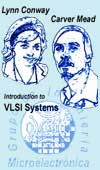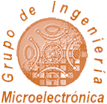
Web Map

Location

News

Santander Info

|
| GIM>Research>Embedded Systems Spe... |
| RESEARCH LINE: |
| | Embedded Systems Specification |
| Select these links to see PROJECTS or PUBLICATIONS within this research line |
| |
| STAFF: |
Eugenio Villar (Responsible for this Research Line)
Fernando Herrera
Pablo Peñil
|
| WORK FIELDS: |
Currently, our activity in electronic specification is focused on system specification for performance analysis and HW/SW co-design as an evolution of our previous activity in VHDL digital description. A first work was the study of the requirements that a system specification language should satisfy when applied to co-design. Ada was the first choice and its translation to VHDL for HW synthesis, analyzed [LVSV97][ViVe98][ViDe98][ViLo99][LVV99], the advantages provided by the system-level specification in the reusability of virtual components [HSUV99] and a comparative analysis of several languages on a common benchmark [GMN00].
As a consequence of our participation to BELSIGN, a close cooperation to the CTIT of the University of Twente was held with the objective of specifying a flexible architecture for HW/SW co-design and implementation of the ATM adaptation layers. This system constituted a case study of the proposed specification and co-design methodologies [TVH96a][TVH96b][AVHG97][AVVH98a][AVVH98b]. Under this collaboration, H.W.A. Teunissen from the CTIT stayed at the GIM and A. Antón and E. Villar stayed at the CTIT.
Among the different alternatives, SystemC has gained a wide interest from both the system design community and CAD vendors [FeVi08]. Its usage has consolidated once aproved as IEEE standard. The previous experience on Ada served as base for studying the actual application of SystemC to the specification of complex, HW/SW embedded systems. This research area started in the FEDER project mentioned above [Vi01b][HeFe01][HCV01].
The heterogeneous system specification methodology in SystemC has shown to be capable to support different computational models [HSV03a][HSV04a][HSV04b][HeVi06a][HeVi06b]. This research activity received an important impulse as a consequence of the stay of Fernando Herrera in the LECS under the supervision of Axel Jantsch. The methodology has been implemented in the SystemC heterogeneous specification library, HetSC [HSV05]. The specification and SW synthesis methodologies constitute a framework for electronic embedded systems design in SystemC [HeVi07]. This framework represents the main contribution of the Ph.D. Thesis with European mention presented by Fernando Herrera [He09]. The library and its fundaments were presented in the ARTIST2 Workshop on Models of Computation and Communication MoCC'06 [Vi06]. This activity was part of the CICYT project previously mentioned [PRO03].
In the project IST 033511 ANDRES the specification methodology for heterogeneous embedded systems in SystemC was formalised with the definition of the valid transformation among models of computation along the design flow. The specification methodology was extended to the design of run-time, reconfigurable systems [HOSN07][HOHS07]. The first results were the analysis of interoperability between HetSC and SystemC-AMS [HVGDH07][HVGDH08] and the deliverables D1.1a y D1.2a. Based on this work, a general specification methodology for heterogeneous, adaptive embedded systems has been defined [HDGHV08][HVH08] based on the integration of specific specification methodologies, (HetSC for adaptive SW, OSSS+R, for dynamically reconfigurable HW, and SystemC-AMS, for analog-digital subsystems) [HDG06][HHF07][GHHHV08]. Modeling adaptive SW is supported by a specific library [RHV09]. The project finished successfully in September 2009 [ICT09]. Nevertheless, afterwards, the capability of the adaptive specification methodology A-HetSC for the design of dynamically reconfigurable HW was shown [HVH11][HUV12].
In the FP7 216807 SATURN [Vi09] project, a formal semantics for different Models of Computation for UML/SysML, UML/MARTE y SystemC modeling and verification environments, was defined [MHM11]. After an analysis of the state-of-the-art [PeVi08a], a first result was an study of MDA-based modeling and code generation methodologies [PeVi08b]. The main contribution of the Microelectronics Engineering Group to the project was the automatic generation of SystemC executables models from SysML and MARTE specifications [PVPM09][PMPV09][PHV11] based on the definition of formal interoperability between MARTE and SystemC [PPV10][Vi10]. This contribution gave formal support to the SATURN modeling, code generation and verification methodology [PeVi09][PVM10][MHM10a][MHM10b]. The experience gained in Saturn served as background for the Complex project.
An interesting aspect of this activity is the specification and verification of timing constraints along the design process [Vi02a].
In the Complex project, as a consequence of a close cooperation with GMV, the UML/MARTE modeling methodology for electronic embedded systems is defined [HPP14]. This methodology is improved in two main aspects in the Pharaon project. On the one hand, enlarging the communication mechanisms among components with the use of channels. On the other, identifying the required executables with the introduction of memory spaces. Both characteristics enable the automatic generation of the SW stack to be executed by each computing node. The possiblity to support several design tasks (i.e. simulation & synthesis), eventualy, all, from the same UML/MARTE model opens the way to the single-source design concept [VNP14]. Another relevant aspect is the modeling of the environment [HPP14].
This specification methodology consolidates in Contrex as the central point around which a single-source framework supporting the modeling, analysis, design and synthesis of complex embedded systems can be built [HMV16]. The methodology incorporates extensions enabling modeling of mixed-criticalities, facilitating design-space exploration [HPV15][HeVi16] and allowing modeling of distributed systems connected through communication networks [EFQ14].
][ViVe98][ViDe98][ViLo99][LVV99]. The integration of embedded systems as part of a System of Systems providing a service to the end-user forces to rethink of the specification, modeling, analysis and design methodologies. In this field, the Internet of Everything (IoE) is considered as the last frontier of electronics, that demands to extend the single-source modeling methodology to services based on functional components that can be deployed on computational resources of different type, from small motes, embedded systems and mobile apps to functions in large data-centers. UML can provide the necessary resources to integrate different domain specific languages into a single system of systems model whose components can be deployed on any computational resource depending on the requirements imposed [MVH17]. |
|
|








